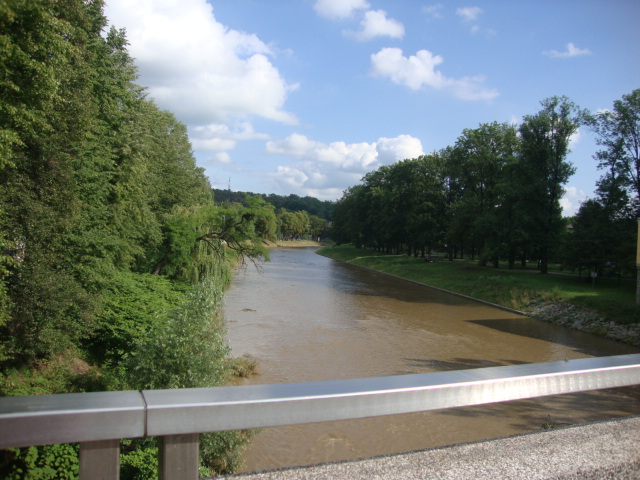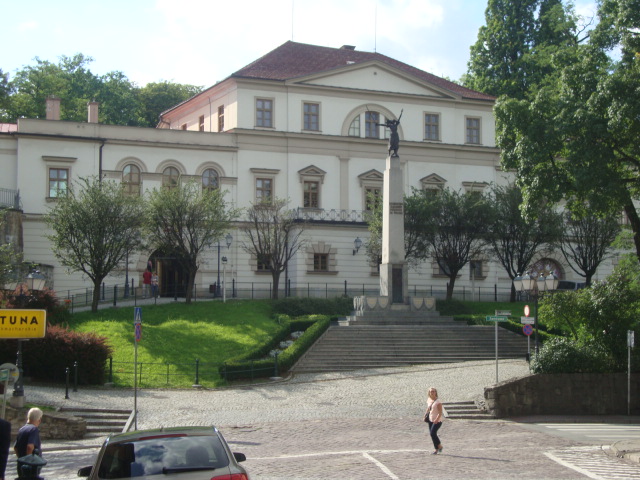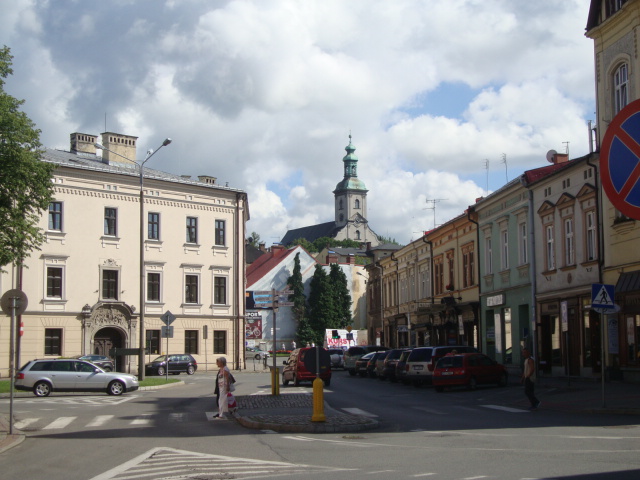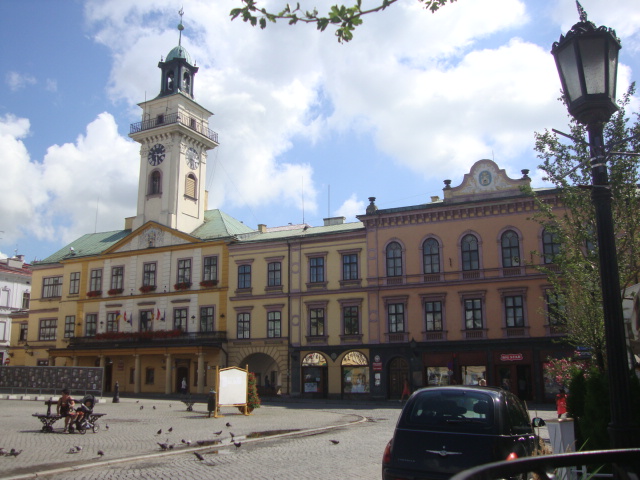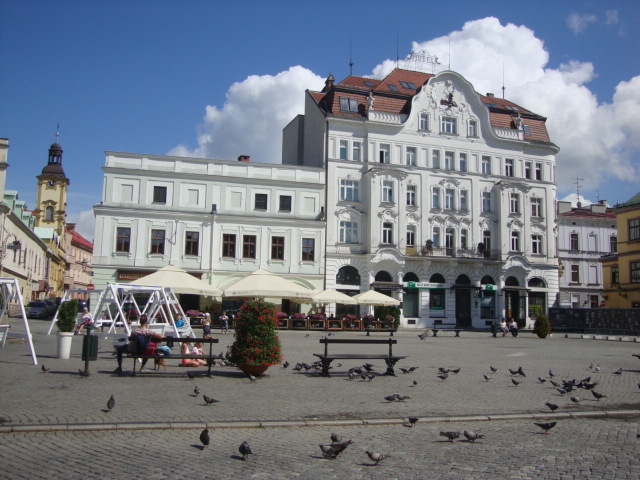Cieszyn
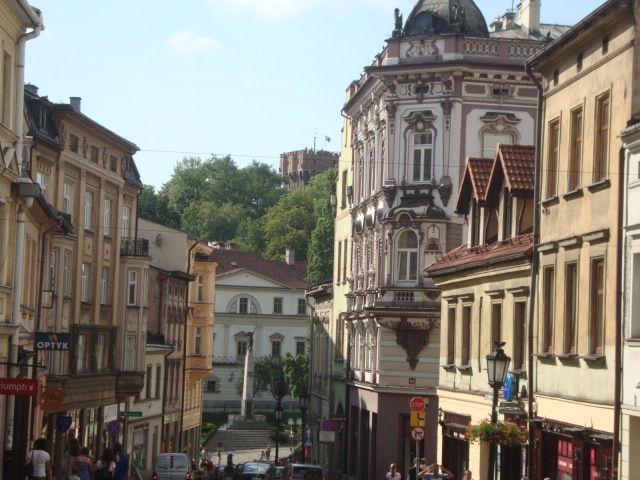
Gaden ul. Głęboka in Cieszyn facing the Hunting Castle and (top) castle
Distance
Population
35.421 (2011)
Location and history
The town of Cieszyn is located in southern Poland, southwest of the Katowice area, right on the Czech border. The Olza River (in Czech: Olše) runs through the city and divides it into a Czech part (on the left bank) and a Polish part (on the right bank). The Czech city is called Český Těšín and is thus officially called to separate it from Těšín, which in Czech designates the Polish city of Cieszyn. There is no major difference in the pronunciation of the city name in Polish and Czech, but the spelling is different. The two languages – Polish and Czech – both belong to the West Slavic languages and are therefore related; of course, it also facilitates cross-border communication. The state of Czechoslovakia emerged after the First World War (1918) on the ruins of the Austro-Hungarian Empire. In 1993, Czechoslovakia was divided into 2 nations: the Czech Republic and Slovakia. Both of these countries, together with Poland, became members of the EU in 2004. The Czech-Polish state border, which as mentioned follows the river through Cieszyn, is thus today an internal border in the EU and the Schengen area and thus an open border.
Unlike the Czech city, the Polish Cieszyn is today very homogeneous in an ethnic sense, with over 96% of the population being of Polish nationality. In religious terms, Cieszyn accommodates both Roman Catholic and Lutheran congregations – to name the largest groups.
Although Cieszyn is today a smaller city, it is an important cultural, administrative and educational center. It is also an important trading town, also for residents of the Czech Republic. In addition to being a district center in Poland, the city is the center of the Cieszyn-Silesia Euroregion. In the city there is a department of the University of Silesia. Every year several festivals are held, including International Theater Festival “Bez Granic” (Without Borders), The Movie Revue “Cinema to Granicy” (Border Film) and Vocal Music Festival “Viva il canto”. A number of cultural institutions and organizations operate in the city. Known in both Poland and abroad is the local folk group Zespół Pieśni in Tańca Ziemi Cieszyńskiej. The location near the Beskid Śląski mountain area, by road and rail connection to the Czech Republic, as well as the attractive historic center and the large number of old, preserved buildings offer the city considerable opportunities for development. Cieszyn's popularity as a tourist center is on the rise. The economy is especially focused on trade and services.
Until recently, there were two road bridges across the river in Cieszyn – the southernmost Freedom Bridge at ul.3 Maja, then the Friendship Bridge at ul.Zamkowa, to which the railway bridge came further north. Farther north, on the outskirts of town (at ul.Graniczna), take the E75 highway across the river. Until the Schengen Agreement came into force, there was the largest border crossing on the Polish-Czech border. In 2012, authorities in the Czech city built a third passenger traffic bridge in the city area itself. The new bridge (called “Sportowy”), however, is reserved for pedestrian and cycling traffic.
Cieszyn is a border town naturally enough in a special situation, has special conditions and a very special history.
Historical introduction:
Cieszyn emerged in the 10th year. as a fortified area to defend the Polish southern border.
The even earlier history in this area is linked to the Slavic tribe Golęszycy, whose territory to the north bordered the land of the Opolanie tribe. South of the Golęszycy tribe lived the tribe Morawianie (Czech: Moravané), as in the 8th-9th centuries. organized themselves in the strong state formation: Velká Morava (Grand Master), ie. a Slavic state that can be described as a precursor to the much later Czechoslovak state.
The settlement that arose in connection with the border fortress developed into an independent city. The city is considered to be founded approx. 1220.From approx. In 1290, Cieszyn was the capital of the independent Principality of Cieszyn-Oświęcim, later in the region that emerged from the Principality: Śląsk Cieszyński (Cieszyn-Silesia). From the time of the Reformation, the inhabitants of the city were divided into several religions and different nationalities. In addition to Poles, Germans, Czechs, Jews and later also Hungarians lived here. The dispute over Cieszyn-Silesia's national affiliation caused the city to be divided in 1920 – with the river as a natural boundary.
A little about the history of Silesia:
Slavic tribes immigrated to the Silesian region from the beginning of the 500s. The first formations of state that included parts of Silesia were Velká Morava (Grand Master) and Čechy (Bohemia). In the 10th year. incorporated Mieszko In Silesia in the Polish state. Here the area remained until the division of the land into duchies took place. Silesia was divided into several independent principals led by princes of the Piast dynasty. In the Middle Ages, the German – cultural and ethnic – influence grew due to the many immigrants from German-speaking areas to the west. Around 1290, the Czech king, Václav II, gained supremacy over the principals of Upper Silesia. Subsequently, Silesia came under the Czech crown during the Holy Roman Empire and as such it was subject to the Habsburg monarchy in 1526. In 1742 most of Silesia was conquered by Friedrich der Grosse and gained the status of a province in Prussia. After World War I, Lower Silesia remained under Germany, but Upper Silesia was divided between the resurrected Polish state and Germany. Austrian Silesia, the small part of the region that Austria retained after the Silesian wars, became part of the new state of Czechoslovakia and is now part of the Czech Republic. The Czech name in the area is: Slezsko. After 1945, both Lower and Upper Silesia were occupied by the Soviet Union. According to the Potsdam agreements, most of the area was left to Poland. As a result, the German population was expelled and replaced by immigrants from the former Polish lands to the east, who had now become part of the Soviet Union.
Byens Cieszyn’s story:
Cieszyn is one of the oldest cities in Silesia. The origins of the city are partly the Borough mound (Góra Zamkowa), where the oldest traces of dwellings date back to the 6th century. before our time, partly the Slavic fortified settlement a few kilometers north of the present Czech part of Cieszyn ie. west of the river. After this settlement had been destroyed by the Great Moorish army at the end of the 8th century, Slavic settlers erected a new fortified settlement on what later became the castle mound at present Cieszyn. In the 11th year. built a Romanesque-style chapel preserved to this day. At the same time, a settlement spread at the foot of the castle mound, and the fortress in Cieszyn was elevated to the center of a bourgeoisie subordinate to the Polish king – until the disintegration of the kingdom took place, after which it belonged to the Silesian princes. The first, sure, written mention of Cieszyn (Tessin) dates from 1155, but unofficially, however, it is believed that the site is also mentioned in documents relating to the year 1000. In the 12th year. Cieszyn was one of the most important fortresses of the Principality of Opole-Racibórz. The official foundation (with the granting of market town rights) took place about 1220. Ca. In 1240 a parish church was built in the city.
In the Middle Ages, Cieszyn along the Olza and Bobrówka rivers was surrounded by ramparts of earth and wood as well as palisades and to the southeast by a ravine with a moat, outside of which, among other things. was a Dominican convent, founded in the second half of the 13th century.
After the division of the Principality of Opole-Racibórz around 1282 and later the division of the Principality of Racibórz in 1290, Cieszyn became the capital of the Principality of Cieszyn-Oświęcim, and the first prince became Mieszko, the founder of the Cieszyn-Piast dynasty. As the capital, the city continued to evolve.
Prince Przemysław In Noszak, in 1374, Cieszyn granted new market town rights according to pattern from Wrocław and built a foundation-walled castle instead of the former wooden building. Around the same time, a mayor and city council were appointed and a town hall was built at the newly created square (the current Stary Targ). Probably there was also a hospital in the city at that time. Cieszyn was now one of the most important and largest cities in Silesia.
A new development followed under Kazimierz II, who in 1496 moved the square to the present site and surrounded Cieszyn with a city wall of stone. In the wall were three gates: Brama Wodna and Brama Frysztacka near the castle and Wyższa Brama on the opposite side of the city. He also appointed a noble court.
Development continued in the 16th century, but in the 17th century. there was major destruction in the city during the 30-year war. In 1653, the line of the Cieszyn-Piastians became extinct; power was now directly taken over by the Czech kings – and thus the Habsburg monarchy, which led to some economic and political stagnation in the city.
The end of the Counter-Reformation period enabled the building of a large Evangelical-Augsburg church in Cieszyn in the years 1709-1750; this church is now the largest Lutheran church in Poland. The city's position was reinforced by the end of the Silesian wars in the middle of the 18th century, when Cieszyn, as one of the few cities in Silesia, remained under Austria. In 1779, the peace agreement between Austria and Prussia was signed. However, progress in the city was soon interrupted by a series of natural disasters: fires and an earthquake. In particular, the rebuilding after the devastating fire of 1789 took several years; on the other hand, the majority of the buildings erected at that time have continued to this day.
In 1802, Leopold Szersznik created a museum (the current Museum of Cieszyn-Silesia), now considered to be the first public museum in Poland. When threatened by Napoleon's forces in 1805, the imperial court and the Austrian government moved to Cieszyn, which for a short period could be said to be the capital of the empire. In 1839 the castle of the Piast dynasty was demolished; At Borghøjen a classic mansion was built with a park – and in this form Borghøjen has continued to this day. A new fire in the city center in 1836 also damaged the town hall; this was rebuilt in 1846 and has since remained unchanged. In 1848, the first newspaper in Polish was published in the city (Tygodnik Cieszyński) Around this newspaper a growing national, Polish, movement gathered. When the railroad came to Cieszyn in 1869, the railway station was built on the west side of the river and around the station an industrial block soon grew. However, industrial development occurred relatively slowly in Cieszyn, so in this respect the city lost ground compared to neighboring Bielsko-Biała. Cieszyn’However, its significance as an administrative and cultural center did not change. From 1911, a tram line connected the railway station with the city center on the eastern riverbank. During World War I, considerable forces from the Austrian army were stationed in Cieszyn, and for a period the city was the seat of the army general.
After the fall of the empire and the end of World War I, Cieszyn and the Cieszyn region became the subject of a territorial dispute between Poland and Czechoslovakia. In January 1919 it even came to war. The dispute first came to an end by the decision of the Council of Ambassadors in Paris in 1920, which divided Cieszyn-Silesia. The town of Cieszyn was divided along the river Olše, so that the historic part of the city was now Polish, while the industrial district with the railway station was located in Czechoslovakia. The division did not take place on an ethnic basis, and therefore a large proportion of the inhabitants of the new Czech town were Poles. The separation from the railway station and the industrial area was, of course, not in favor of the Polish city, and this hampered development to some extent. Between 1938 and 1945, the two boroughs were reunited, with the Polish army occupying the Czech borough in 1938 and an area east of the 1920 border – the so-called Zaolzie, while in September 1939 the whole of Cieszyn-Silesia was occupied and included in the Third Reich. . Immediately after the end of World War II, the division of the city and the area was restored. After 1945, not quite the same dynamic development occurred in Cieszyn as in other Silesian cities. The city was mainly known for the largest border crossing on the southern border and for products from a number of medium-sized companies: Olza, Celma, Polifarb Cieszyn, Polwid, Termika, Zampol and others. The administrative leadership of the region was taken over by Bielsko-Biała. As a cultural center in the area, the city first got a rebirth in the 1990s.
The Olza border
Tourist attractions
Cieszyn has retained its medieval town plan with several building monuments. Borghøjen is one of the most interesting parts of the city. finds the Romanesque roundabout from the 11th century. – one of the oldest Christian churches in Poland; Piast Tower from the 14th century. – the only preserved of the former 4 towers of the type which surrounded the upper castle – with an excellent view of the city and its surroundings; The Last Defense Tower – a remnant of the upper castle's defense system; The Habsburg Hunting Castle, which today houses Śląski Zamek Sztuki in Przedsiębiorczości, an institution for the promotion of arts and crafts, as well as the State Music School.
Castle hill (Wzgórze Zamkowe)
The mound is the oldest residential site in Cieszyn; it was inhabited as early as the 5th year. BC. From the end of the 10th century. there was a border here in the Polish state; the castle on the hill became the center of a castle district before 1155 and was thus the residence of a castle. In 1290, the fortified settlement became the capital of the Principality of Cieszyn, so the castle was then a princely residence. In the 14th century. a ground-walled Gothic defense castle was built, consisting of: 1: the upper castle with residential buildings surrounded by a wall with a brick tower and a central tower as well as a castle chapel in the courtyard and 2: the lower castle where there were basements, operating rooms and housing for the employees – with brick towers and a wind bridge. What led to the decay of the princely castle was primarily the Thirty Years War from 1618 to 1648 and the extinction of the Piast line (1653). After 1653, the castle was the seat of Komora Cieszyńska, a governing body responsible for the financial administration of the properties and land that belonged to the Principality of Cieszyn; this body was created after the takeover of the Habsburgs. Until 1918, the site was also the summer residence of the Habsburg genus, which in 1884 – on the foundations of the lower castle – had Pałac Myśliwski (Hunting Castle) erected. The rest of the castle area was laid out as a park, where today as remains of the former castle you can see the Piast Tower and St. Nicholas Rotunda. On the remains of the cylindrical defense tower, an artificial ruin was built in 1914-16 that gives a certain impression of the function of this tower in its time.
Castle chapel (Kaplica zamkowa)
One of the oldest sacred buildings in Poland is this Romanesque roundabout on the Borgh Hill in Cieszyn. It was built in the first half of the 11th year. of local bricks. The roundabout was listed as a castle chapel, but also as a defensive object and gathering place for the leaders of the site. In the 14th century. the building was rebuilt in Gothic style, as the pointed arched window openings today bear witness to. Concerts with chamber music are regularly held in the renovated building, and every year, December 6 (St. Nicholas Day), worship services are held. The roundabout is open to visitors throughout the year.
Piast Tower (Wieża Piastowska)
The stone tower, built over a square floor plan, was erected in the 12th or 13th century. as part of the castle's defense system. It was expanded in the second half of the 14th century. and embellished on the corners of the coat of arms with the eagle of the Piast family. At the end of the 15th century. the tower was elevated one more floor, provided with weights and brick walls. The whole thing was covered with a high pitched roof. In the middle of the 19th century. the tower underwent a renovation, giving it the current look. In the 19th century. the Piast Tower was also the bell tower.
The Last Defense Tower (Wieża Ostatecznej Obrony)
“The last defense tower” is a well-known concept in citizen architecture. It is known by different names (bar peace, castle tower, central tower, nuclear tower, donjon, keep, stołp), but one of the purposes of this element of the defense system was the same: to secure the castle's residents and defenders in the event of success the enemy who besieges and attacks a castle, to penetrate through the outer defenses and into the inner courtyard, ie. the upper castle. The refuge building, most often built as a tower, was easily accessible, with thick walls, winding stairs and an entrance door that sat high up on the wall, to which was accessed via a loose staircase that could easily be removed. The tower was heavily fortified and also served as an observation point. In the lower part of such a tower, prisons were often furnished, while the other floors served residential and defense purposes.
Archaeological studies on the Borghøjen have revealed some new parts of the former castle, most notably the cylindrical tower. The tower is built of limestone and has a diameter of 12 meters and a wall thickness of 4.2 meters. The tower that has become known has a height of 12 meters, which, from the knowledge of similar buildings, is estimated to be approx. half of the original height. The tower was probably erected in the second half of the 13th year. and as the then most important defense element was built in the northwest of the upper castle. In its construction, the violence of the early medieval fortification was used as a foundation. at the top was the tower with crenelation, ie. peaks and shoots, which were again covered with a tapered wooden roof. In the 14th century, when the castle was expanded and surrounded by a ring wall, the tower was part of the structure of the ring wall as a corner wall tower. After the Thirty Years War (1618-1648), the castle began to decay and ended up as a mere ruin. In the 19th century. the remains of the cylindrical tower were covered with stones and earth. In 1916, an artificial ruin was erected on the site, creating a romantic corner in this part of the castle park. In connection with the archaeological excavations, several examples of houseware, various metal objects, stoves, and not least many silver coins have been found. In 2001-2002, the remains of the tower were renovated, giving the preserved part its original appearance.
Remains of the gate tower
from the end of the 13th century. – In the case of defense facilities such as a fortified city or a citizen, the gateway was one of the most important elements. But at the same time, the very existence of an opening in the violence or ring wall made the gate the weakest point in the entire defense system. Therefore, a number of building elements for defense purposes were assembled at this location, such as a gatehouse with a living room for the guard, a gate passage with a drop grid, a moat with a gantry or a gate tower. In Cieszyn Castle, the upper castle was separated from the lower castle by an inner south wall (which does not exist today) with a gate and a gate tower. This tower had thick stone walls and narrow fire holes and was connected to the weights at the top of the ring wall.
Hunting Lodge
Hunting Lodge (Pałac Myśliwski)
The castle was built in 1838-40 in the Viennese classicist style by drawings by Joseph Kornhäusel of Vienna. The building, which was to be the summer residence of the Habsburg family, was built on the remains of the lower castle. The castle stands with the facade facing the city. The middle part with 3 floors is surrounded by two side floors with 2 floors. Next to the residence was an orangery in the past. Franz Liszt gave concerts. On the first floor a special occasion was arranged for Emperor Franz Joseph. Today, the State Music School is housed in the building, which also – partly in the castle and partly in the reconstructed orangery – houses Śląski Zamek Sztuki in Przedsiębiorczości, an institution for the promotion of arts and crafts. Finally, there is a cafe, wine room and tourist office.
Dom Narodowy
The address Rynek 12 dates from 1901, where it was called Dom Polski and was a cultural and political center for the Polish population. Today, the house is the seat of the Cieszyn Cultural Center.
Church and Monastery of the Merciful Brethren (Bonifratres)
The church dedicated to the Assumption of the Virgin Mary forms a building square with the monastery. The Order The Merciful Brothers of St. John of God came to Cieszyn in 1696. The church was built in 1697-1714 and rebuilt in 1788. Both the church and the monastery were extensively renovated in the 19th and 20th centuries. At the monastery a hospital and a pharmacy were set up. In the hospital, everyone was treated regardless of belief, nationality or financial ability. Under the current railway grounds, a cemetery existed for those who died in the hospital. The orderly brothers, on the other hand, were given a burial place in the monastery area. The former monastery hospital now houses a home for mentally ill men, still under the order of the order.
St. George's Church (Kościół św. Jerzego)
The church is located at ul.Liburnia, near the small river Bobrówka, a tributary to Olza. It originates from the transition between the 14th and 15th centuries. and was erected at that time in a suburb outside the city wall. Originally it was a chapel – built next to a then existing home for poor residents. Later it became branch church. Expanded in the 19th century.
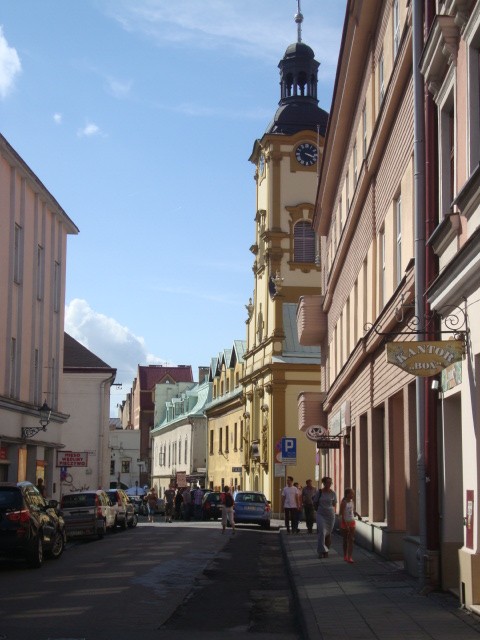
Ul.Szersznika with the Holy Cross Church
Holy Cross Church
at the intersection of ul.Szerznika and ul.Szeroka occurred in the early 18th century. as an extension of a princely chapel. The building has been rebuilt several times. The tower first came into existence in 1781.
Trinity Church
The church originally emerged (in 1585) as a tree-built chapel in a cemetery for victims of a plague epidemic. The construction was financed by Princess Katarzyna Sydonia. The chapel was replaced in 1594 by a walled church that belonged to the Protestants until 1653.
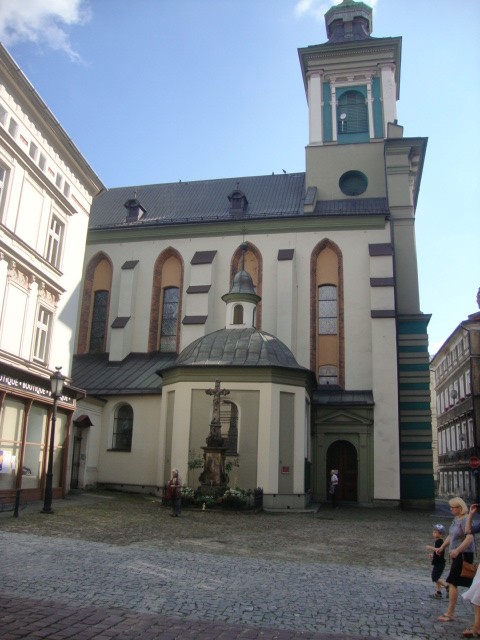
Church of Mary Magdalene
St. Mary Magdalene's Church
Gothic-style Plac Dominikański was built in the 13th century. At first the church belonged to the Dominican Order, but during the Reformation – between 1544 and 1611 – it was taken over by the evangelical congregation. From 1611 to 1789 the church again heard the order. After the fire of 1789, when the Dominicans left Cieszyn, the building became a parish church. The church was rebuilt in Baroque style, which look it has preserved to this day.
Saint Elisabeth Sisters Monastery
The Nunnery Convent and Hospital are located on a slight elevation in the terrain and were built in 1900-1903.
Borromeus-Sisters Monastery
is located by ul.Górny Rynek. After the sisters came to Cieszyn in 1876, they bought a plot of land for the monastery. Next to the monastery a chapel was built. In Cieszyn, the sisters engaged in educational activities; they have thus run an elementary school, a household school and a kindergarten. In addition, they have provided a boarding house.
From the center of Cieszyn overlooking the Jesus Church
Jesus Church
at Plac Kościelny was erected in 1709-22 in the late Baroque style as an evangelical church according to drawings by the architect Johann Hausrücker of Opava.
The district court in Cieszyn
The current courthouse dates from 1905, but the history of the judiciary in Cieszyn goes back to the 13th century.
City Hall in the square
City Hall
Address: Rynek (Torvet) no. – By the end of the 15th century. Prince Kazimierz II erected in this place a ground-walled town hall with a wooden tower. This town hall burned in 1552. The rebuilt town hall was damaged during the 30-year war, but repaired in 1661. The town hall was again damaged by the fire in 1720. After a new fire in 1789, the rebuilt town hall was inaugurated in 1800. The town hall tower was last renovated in 1984.
Ulica Głęboka (Deep Street)
This street, originally called Ulica Polska, was from the early Middle Ages the main artery of the city, connecting the city center with the castle. The later name of the street is due to the submerged form of the roadway due to the particularly high sidewalks. From Głęboka Street, there are still direct views (to the northwest) to the upper part of Piast Tower, the most striking remnant of the old castle.
(See the image at the top of the page).
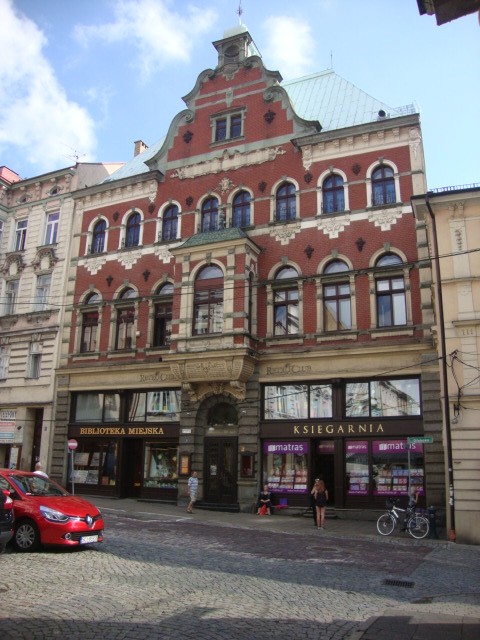
The German House – with public library and bookstore
Library building (Dom Niemiecki), ul.Głęboka 15
The house in Głęboka Street, which now houses a public library and a bookstore, was formerly known as Dom Niemiecki (German House). The house was built in its present form at the end of the 19th century. in Dutch neo-Renaissance style with richly curved gable facade and interesting interior. This as well as the former building at this place stood near Stary Targ (Old Market Square), one of the most important plates in Cieszyn of old. The house was formerly a noble residence belonging to several wealthy, local families.
Ulica Górny Rynek (Upper Peat)
This square was built in the 18th century. In the square, cattle were first traded, then mostly with timber, which is why the square was also called Drewniany Rynek (Tømertorvet).
‘‘Cselestinum’‘
by ul.Kochanowskiego is a former “konwikt”, i.e. a form of boarding school for students attending a school, led by an order under the Catholic Church. The boarding school was founded in 1796. The current building dates from 1824, in a classicist style with mansard roofs and a pillar-bearing entrance (porticus). The house now houses the municipal civil office and the municipal security guard.
Bludowski-house
at ul.Mennicza (Møntergade) no. 46. – In 1719, Baron Jerzy Bludowski rebuilt the former coin workshop into his residence. From the 13th century the princes of Cieszyn had the right to coin. – By the end of the 19th century. the facade was decorated by architect Eugen Fulda.
The old shooting house
The building was operating in the early 19th century. as a shooting house for the Cieszyn Shooting Company, founded by Leopold Szersznik in 1790. It is a classicist building erected on the site of a Franciscan monastery that operated here until 1545.
Ulica Przykopa
This street, where the current buildings mainly date from the 18th century, is characterized by its small bridges over the canal Młynówka (therefore called Cieszyn’s Venice). Ulica Przykopa used to be a craftsman's street, where tanners, weavers, dressmakers, blacksmiths and glovesmakers all needed water for their production.
Ulica Ratuszowa (Rådhusgade)
Noteworthy here is the former classicist theater building from the mid-18th century, rebuilt in 1816 and rebuilt in 1816 after a fire, along with the town hall, after drawings by Austrian architect Joseph Georg Kornhäusel. The building is now a cinema.
Larisch Mansion / Museum
The former Larisch mansion was at that time the residence of Count Jan Larisch. The building was erected after the great fire in 1789 on the foundations of a few smaller townhouses. The main facade towards ul.Regera is in Baroque and classicist style, the facade facing the park rests on the remains of the city wall. In the rear wing, in 1840’the eres built a special horse stable; it is a beautiful, round room at 2 storeys height, where today a café is furnished. Behind the mansion are the garden and the Peace Park. The mansion today houses the Museum of Cieszyn-Silesia.
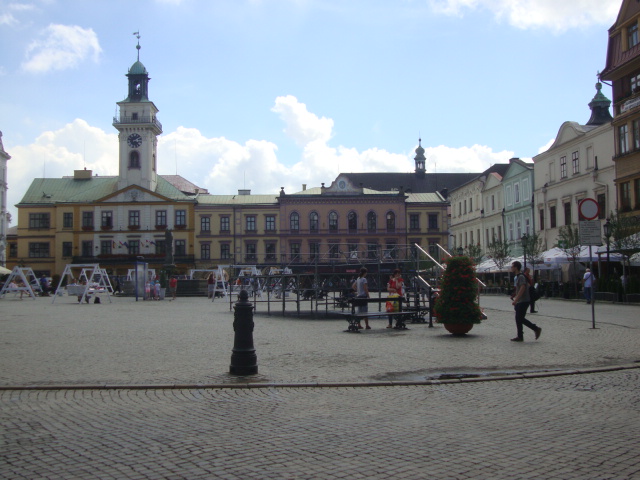
Square
Square (Rynek)
At its present location, the square emerged at the end of the 15th century. Here are some of the most important municipal buildings, including the town hall as well as a number of houses belonging to the wealthiest citizens, with archways and erected in the 16th century. in the Renaissance style. However, today the oldest parts of the houses are only preserved in the basement and living room level. In general, most of the houses at the square have found their present form and appearance in the 19th century. Even at the beginning of the 20th century. the square served as a marketplace.
‘Pod Brunatnym Jeleniem’
Hotel “Under the Brown Deer” (‘‘Pod Brunatnym Jeleniem’‘)
by the square was built in 1912 by drawings by architect Kohler from Vienna and with decorations and interiors in Viennese baroque style. This place existed in the 18th century. a guest house by the name “Under the Golden Crown”. In the hotel “Under the Brown Deer” many well-known people from home and abroad have been guests, including the emperors of Austria-Hungary and Russia.
Noble Assembly building
at ul.Sejmowa. This building was held from the end of the 17th century. local nobility assemblies. In 1779, the Treaty of Peace for the Cieszyn Peace was signed. The building was rebuilt in the 18th century. In the past, the interior of the house was decorated with weapons for a large number of noble families.
The former brewery
by ul.Śrutarska. The classicist building, erected quite near the old city wall in the 18th century. and rebuilt after a fire in 1810, was Cieszyn’s urban brewery. The city's arms can still be seen on the facade, where you can also read an inscription stating that the building, under the patronage of Emperor Franz and with the support of Prince Albert of Cieszyn and on the basis of a decision of the city council and mayor, was erected for the well-being of the citizens.
The Well of the Three Brothers (Studnia Trzech Braci)
The name of the well refers to a legend about the rise of the city, where three brothers meet at this well. In the 14th century. belonged to the well Dominican Order, later the city brewery was given the right to use water from the well. In 1868 a small cast iron gazebo was built on the site with a text referring to legend.
Well of Saint Florian
the square is a remnant of the old water supply in the city. Originally, the well was made of wood, but since the second half of the 16th century. of stone. The stone figure of Saint Florian on a square foot piece in the middle of an octagonal basin is probably done by W. Donay in 1770’s.
“Under the Golden Ox”
This former guest house is located on Górny Rynek and was built in the year 1800. In the 19th century. it was the accommodation of the people who drove cattle from Galicia to Vienna. The house was rebuilt in 1874 and has been the seat of numerous associations and institutions, including the People's Reading Room (Czytelnia Ludowa).
Madonna with the baby
This sculpture on Stary Targ dates from the second half of the 14th century. and is done by sculptor Peter Parler from Prague. It is one of the few Gothic stone sculptures preserved in the Cieszyn area. The original can be found at the Museum of Cieszyn-Silesia.
The former General Vicariate of the Diocese of Wrocław
The building that formerly contained the General Vicariate of the Diocese of Wrocław (1770-1925) is in neo-Baroque style and erected in 1894 at the site of a demolished Dominican convent. The house is now the parsonage for the parish of the Church of Mary Magdalene.
nature reserves
There are three nature reserves in Cieszyn, close to the built-up area, where efforts are made to preserve parts of the special flora in the area. One of the reserves – created in 1961 – is also used as a city park.
One of the plants protected in the reserves is “Yellow spring screen”, native to central Europe, but in isolated regions. In Poland, it occurs most frequently in the Cieszyn area, which is why, with the latest Polish name, the plant has been named after the city: Cieszynianka wiosenna.
Surrounding Area
Accommodation
Booking.com
Cieszyn (City's own page – in Polish, English, German, French and Czech)
Other Internet sites and sources
Cieszyn (City's own page – in Polish, English, German, French and Czech)
Translated into English by Google Translate. Spangshus.dk accept no liability for any errors or omissions in translation.
Map

Rating
Search
Most used tags
churches (205) Castles (86) Monasteries (79) Town walls (74) Lakes (71) Town halls (67) Rivers (65) Castles1 (62) Mansions (55) Museums (51) Regional museums (38) Town gates (36) Abbey churches (35) Castle ruins (30) Cathedrals (26) Forests (25) Health resorts (24) Mounds (23) Water sports (23) National parks (22)Click for all tags
Denne side er også tilgængelig på dansk. This page and contents is (c) Copyright 2018- www.spangshus.dk. Based on Inviator software by ISCA Software
